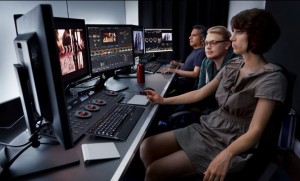University degrees: Postgraduate
Course length: 9 months
Course city: Berlin
In analogue film workflows, colour timing was the widespread but very limited process deployed to adjust a film’s look technically and creatively. Colour timers were generally film-lab employees. With the rise of electronic imaging, expensive film-to-video transfer equipment (telecine) offered a much wider range of image manipulation options and triggered a new wave of post-production visual design in the film world. Training on this equipment was only possible in large post-production facilities, and involved spending years as an assistant in order to master the telecine process.
The increasing emphasis on post-production in modern filmmaking gives rise to growing demand for professionals to master post-production techniques in both artistic and technical terms. Furthermore, the market for highly qualified colourist is set to expand, for they are the principal creative collaborators in image post-production.
The transition to computer-based digital colour grading systems offers broader access, but so far there has been no targeted long-term training for professionals in this specific field.
That’s why the DFFB created the world’s first intensive long-form postgraduate training programme dedicated exclusively to colour correction: UP.GRADE – Colouring Tomorrow. For four years UP.GRADE trained 40 young colorists over 9 intensive months in the technical, theoretical, practical, and aesthetic aspects of colour grading.
Through UP.GRADE, the DFFB has been able to satisfy the enormous demand for knowledge that has arisen from the digitalisation of all production processes over the last 15 years.
The curriculum of UP.GRADE is based on the idea of combining theory with handson exercises in artistic, communcative and technical fields. From discussions with established colourists, post-production supervisors, post-production facility managers and cinematographers, a curriculum was developed to cover all topics relevant for successful colourists today. These encompass
We also offered ecxercises to immediately apply theory e.g. through an actual short film producion where each participant would be involved from pre-production to conforming and doing the final colour grading. This assignment also provided an opportunity to practise the very challenging aspect of communicating colours and emotions with the directors and cinematographers.
We covered the thre most used colour grading tools on the market:
Our working stations included professional displays and control panels. These tools were avialable for several months in order for the participants to be able to solidify their knowledge and internalize the practice. Aspects of communicating emotions and supporting the narrative were also discussed in lectures and masterclasses with experienced colourists and cinematographers.
